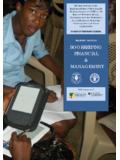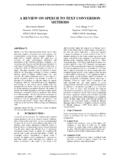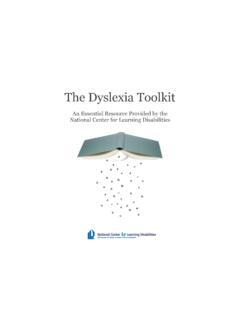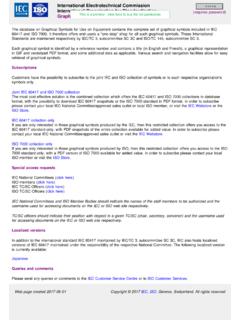Transcription of NRS Educational Functioning Levels - Minnesota Adult Basic ...
1 15 NRS Educational Functioning Levels Outcome Measures Definitions Educational Functioning Level Descriptors-- Adult Basic Education Levels Literacy Level Basic Reading and Writing Numeracy Skills Functional and Workplace Skills Beginning ABE Literacy Test Benchmark CASAS: 200 and below Individual has no or minimal reading or writing skills in any language, and may be able to read and write own name or single isolated words. The individual may be able to write letters or numbers and copy simple words and there may be no or incomplete recognition of the alphabet, may have difficulty using a writing instrument. There is little or no comprehension of how print corresponds to spoken language.
2 Individual has little or no recognition of numbers or simple counting skills or may have only minimal skills, such as the ability to add or subtract single digit numbers. Individual has little or no ability to read Basic signs or maps, can provide limited personal information on simple forms and has few or no workplace skills. The individual can handle routine entry level jobs that require little or no Basic written communication or computational skills and no knowledge of computers or other technology. Beginning Basic Education Test Benchmark CASAS: 201-210 Individual can read and print numbers and letters, but has a limited understanding of connected prose and may need frequent re-reading; can write a limited number of Basic sight words and familiar words and phrases; may also be able to write simple sentences or phrases, including very simple messages.
3 Narrative writing is disorganized and unclear; inconsistently uses simple punctuation ( , periods, commas, question marks); contains frequent errors in spelling. Individual can count, add and subtract three digit numbers, can perform multiplication through 12 can identify simple fractions and perform other simple arithmetic operations. Individual is able to read simple directions, signs and maps, fill out simple forms requiring Basic personal information, write phone messages and make simple change. There is minimal knowledge of, and experience with, using computers and related technology. The individual can handle Basic entry level jobs that require minimal literacy skills; can recognize very short, explicit, pictorial texts, understands logos related to worker safety before using a piece of machinery; can read want ads and complete simple job applications.
4 16 NRS Educational Functioning Levels Outcome Measures Definitions Educational Functioning Level Descriptors-- Adult Basic Education Levels Literacy Level Basic Reading and Writing Numeracy Skills Functional and Workplace Skills Low Intermediate Basic Education Test Benchmark CASAS: 211-220 Individual can read simple material on familiar subjects and comprehend simple and compound sentences in single or linked paragraphs containing a familiar vocabulary; can write simple notes and messages on familiar situations, but lacks clarity and focus. Sentence structure lacks variety, but shows some control of Basic grammar ( , present and past tense), and consistent use of punctuation ( , periods, capitalization) Individual can perform with high accuracy all four Basic math operations using whole numbers up to three digits; can identify and use all Basic mathematical symbols.
5 Individual is able to handle Basic reading, writing and computational tasks related to life roles, such as completing medical forms, order forms or job applications; can read simple charts, graphs labels and payroll stubs and simple authentic material if familiar with the topic. The individual can use simple computer programs and perform a sequence of routine tasks given direction using technology ( , fax machine, computer operation). The individual can qualify for entry level jobs that require following Basic written instructions and diagrams with assistance, such as oral clarification; can write a short report or message to fellow workers; can read simple dials and scales and take routine measurements.
6 High Intermediate Basic Education Test benchmark: CASAS: 221-235 Individual can read text on familiar subjects that have a simple and clear underlying structure ( , clear main idea, chronological order); can use context to determine meaning; can interpret actions required in specific written directions, can write simple paragraphs with main idea and supporting detail on familiar topics ( , daily activities, personal issues) by recombining learned vocabulary and structures; can self and peer edit for spelling and punctuation errors. Individual can perform all four Basic math operations with whole numbers and fractions; can determine correct math operations for solving narrative math problems and can convert fractions to decimals and decimals to fractions; can perform Basic operations on fractions.
7 Individual is able to handle Basic life skills tasks such as graphs, charts and labels, and can follow multi-step diagrams, can read authentic materials on familiar topics, such a simple employee handbooks and payroll stubs; can complete forms such as a job application and reconcile a bank statement. Can handle jobs that involve following simple written instructions and diagrams; can read procedural texts, where the information is supported by diagrams, to remedy a problem, such as locating a problem with a machine or caring out repairs using a repair manual. The individual can learn or work with most Basic computer software, such as using a word processor to produce own texts; can follow simple instructions for using technology.
8 17 NRS Educational Functioning Levels Outcome Measures Definitions Educational Functioning Level Descriptors-- Adult Basic Education Levels Literacy Level Basic Reading and Writing Numeracy Skills Functional and Workplace Skills Low Adult Secondary Education Test Benchmark: CASAS: 236-245 Individual can comprehend expository writing and identify spelling, punctuation and grammatical errors; can comprehend a variety of materials such as periodicals and non-technical journals on common topics; can comprehend library reference materials and compose multi-paragraph essays; can listen to oral instructions and write an accurate synthesis of them; can identify the main idea in reading selections and use a variety of content issues to determine meaning.
9 Writing is organized and cohesive with few mechanical errors; can write using a complex sentence structure; can write personal notes and letters that accurately reflect thoughts. Individual can perform all Basic math functions with whole numbers, decimals and fractions; can interpret and solve simple algebraic equations, tables and graphs can use math in business transactions. Individual is able or can learn to follow simple multi-step directions, and read common legal forms and manuals; can integrate information from texts, charts and graphs; can complete forms and applications and complete resumes; can perform jobs that require interpreting information from various sources and writing or explaining tasks to other workers; is proficient using computers and can use most common computer applications, can understand the impact of using different technologies; can interpret the appropriate use of new software and technology.
10 High Adult Secondary Education Test Benchmark: CASAS: 246 and higher Individual can comprehend, explain and analyze information from a variety of literacy works, including primary source materials and professional journals; can use context cues and higher order processes to interpret meaning of written material. Writing is cohesive with clearly expressed ideas supported by relevant detail; can use varied and complex sentence structures with few mechanical errors. Individual can make mathematical estimates of time and space and can apply principles of geometry to measure angles, lines and surfaces; can also apply trigonometric functions. Individuals are able to read technical information and complex manuals; can comprehend some college level books and apprenticeship manuals; can function in most job situations involving higher order thinking; can read text and explain a procedure about a complex and unfamiliar work procedure, such as operating a complex piece of machinery; can evaluate new work situations and processes, can work productively and collaboratively in groups and serve as facilitator and reporter of group work.







